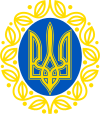Ukrainian National Republic
| Ukrainian People's Republic | ||||||||||||||||
|
Українська Народна Республіка Ukrayins'ka Narodna Respublika |
||||||||||||||||
|
Autonomous part of the Russian Republic (1917–1918) Sovereign state (1918–1921) |
||||||||||||||||
|
||||||||||||||||
|
||||||||||||||||
|
Anthem Ще не вмерла Україна (Ukrainian) Shche ne vmerla Ukraina (transliteration) Ukraine's glory has not perished |
||||||||||||||||
| Capital | Kiev | |||||||||||||||
| Languages | Ukrainian | |||||||||||||||
| Religion |
|
|||||||||||||||
| Government | Parliamentary republic | |||||||||||||||
| President | ||||||||||||||||
| • | 1917–1918 | Mykhailo Hrushevskyi | ||||||||||||||
| • | 1918–1925 | Directorate of Ukraine | ||||||||||||||
| President-in-exile | ||||||||||||||||
| • | 1926–1954 | Andriy Livytskyi | ||||||||||||||
| • | 1954–1965 | Stepan Vytvytskyi | ||||||||||||||
| • | 1965–1989 | Mykola Livytskyi | ||||||||||||||
| • | 1989–1992 | Mykola Plaviuk | ||||||||||||||
| Legislature | Central Rada (to April 1918) Labor Congress |
|||||||||||||||
| Historical era | World War I | |||||||||||||||
| • | 7 November 1917 | |||||||||||||||
| • | Independence | 22 January 1918 | ||||||||||||||
| • | Sack of Kiev | 9 February 1918 | ||||||||||||||
| • | Ukrainian State | 29 April 1918 | ||||||||||||||
| • | Directorate | 13 November 1918 | ||||||||||||||
| • | Soviet invasion | 16 January 1919 | ||||||||||||||
| • | Peace of Riga | 18 March 1921 | ||||||||||||||
| Area | ||||||||||||||||
| • | 1897 | 477,021 km² (184,179 sq mi) | ||||||||||||||
| Population | ||||||||||||||||
| • | 1897 est. | 23,430,407 | ||||||||||||||
| Density | 49.1 /km² (127.2 /sq mi) | |||||||||||||||
| Currency |
Karbovanets Hryvnia |
|||||||||||||||
|
||||||||||||||||
| Today part of | ||||||||||||||||
The Ukrainian People's Republic or Ukrainian National Republic (Ukrainian: Українська Народна Республіка, Ukrajinśka Narodna Respublika; abbreviated УНР, UNR), a predecessor of modern Ukraine, was declared (on 10 June 1917) - at first as a part of the Russian Republic after the Russian Revolution - but proclaimed its independence on 25 January 1918. During its short existence the republic went through several political transformations from the socialist-leaning republic headed by the Central council with its General secretariat to the national republic, led by the Directorate and by Symon Petlyura. Between April and December 1918 the Ukrainian People's Republic did not function, having been overthrown by the Ukrainian State of Pavlo Skoropadsky. From autumn 1919 the UNR operated as an ally of the Second Polish Republic, but by then the state de facto no longer existed. The 18 March 1921 Treaty of Riga between the Second Polish Republic, Soviet Russia (acting also on behalf of Soviet Belarus) and Soviet Ukraine sealed the fate of the Ukrainian People's Republic.
After the Bolshevik Revolution of October/November 1917 many governments formed in Ukraine - most notably the Ukrainian People's Republic (based in Kiev) and the Ukrainian People's Republic of Soviets (1917-1918, based in Kharkiv) and its Soviet successors. These two sides fought constantly with each other, which resulted in many casualties among Ukrainians fighting in a civil war as part of the wider Ukrainian-Soviet War of 1917-1921. The Soviet Union would (after the 1921 Treaty of Riga) extend control over what would ultimately become the Ukrainian Soviet Socialist Republic and a founding member of the Soviet Union.
...
Wikipedia



